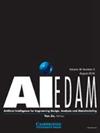需求引出中的机器学习:文献综述
IF 2.3
3区 工程技术
Q3 COMPUTER SCIENCE, ARTIFICIAL INTELLIGENCE
Ai Edam-Artificial Intelligence for Engineering Design Analysis and Manufacturing
Pub Date : 2022-10-26
DOI:10.1017/S0890060422000166
引用次数: 5
摘要
需求提取的一个日益增长的趋势是使用机器学习(ML)技术来自动化繁琐的需求处理过程。这篇文献综述总结和分析了将ML和自然语言处理(NLP)纳入需求引出的研究。我们回答了以下研究问题:(1)ML支持哪些需求激发活动?(2)哪些数据源用于构建基于ml的需求解决方案?(3)使用什么技术、算法和工具来构建基于ml的需求提取?(4)如何构建基于ml的需求激发方法?(5)支持基于机器学习的需求激发方法的可用工具是什么?从这些研究问题中得到的关键词导致了最初从7个科学搜索引擎中检索到的975条记录。最终,86篇文章入选本综述。作为主要的研究发现,我们确定了15个基于ml的需求激发任务,并将它们分为四类。在这篇文献综述中,确定并分类了12种用于构建数据驱动模型的不同数据源。此外,我们将构建基于ml的需求提取方法的技术分为五个部分,分别是数据清理和预处理、文本特征提取、学习、评估和工具。更具体地说,确定了3种预处理方法,3种不同的特征提取策略,12种不同的学习方法家族,2种不同的评估策略以及各种现成的公开可用工具。此外,我们还讨论了目前研究的局限性,并提出了未来研究的八个潜在方向。本文章由计算机程序翻译,如有差异,请以英文原文为准。
Machine learning in requirements elicitation: a literature review
Abstract A growing trend in requirements elicitation is the use of machine learning (ML) techniques to automate the cumbersome requirement handling process. This literature review summarizes and analyzes studies that incorporate ML and natural language processing (NLP) into demand elicitation. We answer the following research questions: (1) What requirement elicitation activities are supported by ML? (2) What data sources are used to build ML-based requirement solutions? (3) What technologies, algorithms, and tools are used to build ML-based requirement elicitation? (4) How to construct an ML-based requirements elicitation method? (5) What are the available tools to support ML-based requirements elicitation methodology? Keywords derived from these research questions led to 975 records initially retrieved from 7 scientific search engines. Finally, 86 articles were selected for inclusion in the review. As the primary research finding, we identified 15 ML-based requirement elicitation tasks and classified them into four categories. Twelve different data sources for building a data-driven model are identified and classified in this literature review. In addition, we categorized the techniques for constructing ML-based requirement elicitation methods into five parts, which are Data Cleansing and Preprocessing, Textual Feature Extraction, Learning, Evaluation, and Tools. More specifically, 3 categories of preprocessing methods, 3 different feature extraction strategies, 12 different families of learning methods, 2 different evaluation strategies, and various off-the-shelf publicly available tools were identified. Furthermore, we discussed the limitations of the current studies and proposed eight potential directions for future research.
求助全文
通过发布文献求助,成功后即可免费获取论文全文。
去求助
来源期刊
CiteScore
4.40
自引率
14.30%
发文量
27
审稿时长
>12 weeks
期刊介绍:
The journal publishes original articles about significant AI theory and applications based on the most up-to-date research in all branches and phases of engineering. Suitable topics include: analysis and evaluation; selection; configuration and design; manufacturing and assembly; and concurrent engineering. Specifically, the journal is interested in the use of AI in planning, design, analysis, simulation, qualitative reasoning, spatial reasoning and graphics, manufacturing, assembly, process planning, scheduling, numerical analysis, optimization, distributed systems, multi-agent applications, cooperation, cognitive modeling, learning and creativity. AI EDAM is also interested in original, major applications of state-of-the-art knowledge-based techniques to important engineering problems.

 求助内容:
求助内容: 应助结果提醒方式:
应助结果提醒方式:


